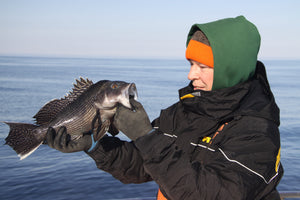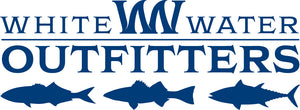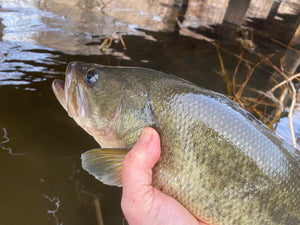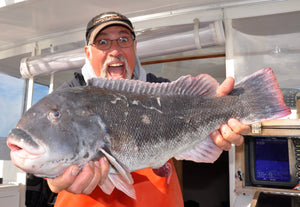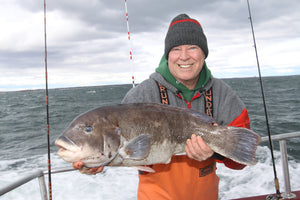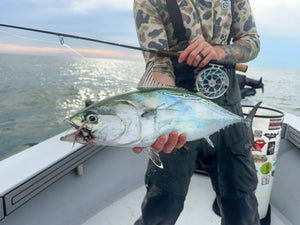Fishing Trends for 2025

Capt. Dave Flanagan (North Island Fly & Light Tackle Guide Service) with a healthy North Shore striper.
It may be hard to believe given the winter weather we’ve experienced over the past few months, but fishing season isn’t all that far off. In fact, it’s already time to be planning those first few trips of the year in hopes of getting off to a fast start. With just that thought in mind, here’s a look at some noticeable trends that picked up steam last year. Consider this food for thought as you fill out your arsenal, pick your points of attack, and formulate your game plans for coming season.
Capt. Dave Flanagan, owner/operator of North Island Fly & Light Tackle Guide Service is no stranger to putting his customers on nice fish with Flutter Spoons when the situation calls for it!
Inshore: Big Lures Tempt Big Bass
“Absolutely number one in terms of productive fishing trends last year on the inshore scene was the continued shift to tossing larger lures for bigger stripers keying on bunker pods,” says White Water Outfitter’s owner, Bryce Poyer. “It’s been a constant topic of conversation at the shop, both with our customers and amongst our staff.”
The shift has been driven by anglers looking for different, fun and more challenging ways to tempt the heifers that hang around tightly packed schools of menhaden. With 30-pounders a relatively easy mark for anyone having a boat that can safely get outside a south shore inlet and a bit down the beach, many anglers who have caught their share of solid fish are looking to up their game by targeting true cows with lures. “One way to separate the decent fish from the real lunkers is to present bigger offerings,” explains Poyer. “Three techniques have really shined in this endeavor: jigging flutter spoons, casting Danny-style surface plugs, and tossing giant rubber swimbaits.”
Flutter spoons have probably created the most buzz over the past two years. It takes a little while to get a feel for using them if you haven’t tried this type of drift fishing before, so you’ll want to invest some time learning how to get your lure down into the strike zone and feeling for appropriate action on each uplift or free-fall of your offering.
Note that flutter spoon strikes can be exceptionally light, often indicated by a slight bump, twitch of the line or a gentle bounce of the rod tip. Figure it all out, though, and you’ll see nothing but smiles along your rails. We have Fat Cow, Jigging World, Ben Parker and Tsunami flutter spoons in stock here at the shop. All are worthy of time at the end of your line.
At the other end of the big spectrum, throwing large Danny-style surface plugs had until recently been considered by many to be an old-school surf-fishing technique. These days, though, it is producing some amazing results with big bass and blues for those willing to toss these full-bodied lures from a boat. To do this right you’ll need a relatively heavy seven- to eight-foot, spinning rod like a St. Croix Premier, or Triumph spinning rod, in H or XH power matched to a size 6000 Shimano Saragosa SWA spinning reel loaded with 30-pound-class braid and topped off with a 40- to 50-pound-test leader. Team this with a 7- to 8” Gibbs, Sporting Wood, or Personal Best, Danny-style surface swimmer and fish it wake bait-style or just below the surface.
“White and yellow should be your go to colors with this technique,” advises Poyer, “although you might want to experiment with a fancy bunker, blurple (black/purple) or olive-backed color pattern when the cows seem to want something a little bit different.”
Throwing giant rubber swimbaits has also made strides recently, and its rewards have certainly earned it a spot in the rotations of local sharpies for the coming season. Because stripers can hold in anything from shallow back-bay waters to 30’ depths or greater, you’ll need to carry various sized jigheads or lure weights. Vary your retrieve every now and then to see if the fish want something moving a little slower, faster, deeper or shallower. Get on the right pattern and you could be in for some seriously good action.
Top choices in this lure category include 8” NLBN Straight Tail Soft Plastics and 7.5- or 9” Lunker City Slug-Go Soft Baits. Both are also smart selections if you plan to head down south for tarpon and snook before striper action resumes in our own backyards.

Offshore: Giant Tuna Await Your Offerings
The continued evolution of tuna jigging is a trend that has really helped put some extra snap into offshore big game hook-ups. To cash in on the fun take some time to learn how to use a Ron-Z 10” Big Game Series Soft Bait, Hogy Tuna Harness Jig or Bill Hurley Tuna Bomb.
You’ll need to figure out how to cast these offerings up-drift and allow them to settle down to the bottom right on your marks. For some people, especially those with a light-touch inshore or even freshwater background, the technique comes almost naturally. For others who have never seriously worked bucktails or light-weight leadheads for fluke, stripers or largemouth bass, however, the learning curve requires more patience.
To get your jig away from the boat and deep on the drift, you’ll need to start with a proper setup. Choose a short, sensitive, 5- to 6-foot Jigging World AMF Jigging Spinning Rod or Centaur Chiron Tuna Adventurer 55S Spinning Jigging Rod. Match either to a size 14000 Shimano Saragosa SWA or Stella SWC spinning reel loaded with 65-pound-test Power Pro MaxCuatro line and a 5-ounce Ron-Z.
Properly outfitted for battle, it’s just a matter of putting in time to practice your presentation before you get on the fish - and completely exhaust every muscle in your body after finally setting the hook.

Surf: Step Down For More Hook-Ups
We all know you need a big stick, gusty reel and a weighty lure to cast into the teeth of a gale as big bass and blues boil just beyond the wash. But there are plenty of days throughout the season when you’re even more likely to tangle with 20- to 30-inch fish feeding on small baits in relatively calm water.
A lot of anglers have taken notice recently as to how significantly a lighter setup and a little bit of downsizing can up their scores when there’s little need to rumble. As a result, carrying a lighter 7’ to 8.5’ surf outfit was seriously trending last year. Expect that theme to spill into the coming season as well.
“In calmer, reasonably shallow water without overpowering current, it just makes sense to lighten up and toss lures meant to imitate sand fleas, sand eels, rain bait and the like,” says Poyer. “Obviously, you can’t really do this if a snotty wind is blowing right in your face, but you can have plenty of fun tossing ½- to 1-ounce bucktails and soft plastics to husky-shouldered schoolies if you pick your spots.
Want to get in on the schoolie fun? Stop by the shop and we’ll help you select the perfect setup for your local action while tipping you off to the hottest local lures.
Another one of Dave Flanagan's (North Island Fly & Light Tackle Guide Service) customers that he put onto a nice fish with a big fly setup! The Long Island Sound has an incredible fishery for big fish on flies and plugs. Give Dave a call to experience it!
Fly Fishing: Bump It Up
As is the case with inshore fishing in general, local fly casters have been trending toward bigger patterns, especially when it comes to targeting stripers and blues around bunker schools. With bunker providing an easy flash point for action with hefty stripers and the occasional gorilla blue, what was once typically a back-bay spot-and-stalk endeavor on the flats has been morphing into something more significant – and it’s a game worth the ante.
Of course, to tempt big fish in big waters with big flies like "beast fleyes" and other big adult bunker patterns, you’ll need to bump up your gear. For those ready to take the plunge, the perfect outfit runs along the lines of a 11wt or 12wt TFO Axiom II-X, Hardy Marksman-Z, or Thomas & Thomas fly rod paired to a Hatch or Redington fly reel loaded with a Sink-7 sinking fly line (preferably with an aggressive compact head).
Yes, that is a big step up from the smaller 7- to 9wt outfits most inshore fly fans throw today, but extraordinary times call for extraordinary measures – and with the number of big bass around these days the time to challenge yourself has arrived. Only one question remains: Are you game?
- Bryce Poyer



